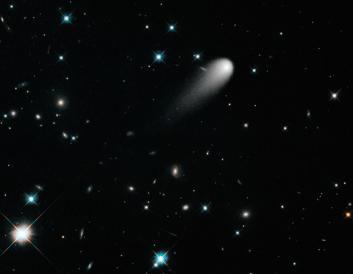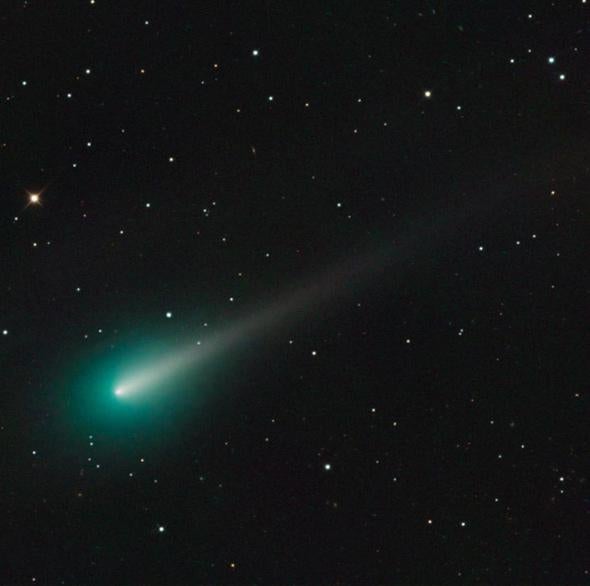The image above is of Comet ISON—technically named C/2012 S1 (ISON)—taken by friend-of-the-BA-blog Adam Block. ISON is a feisty little chunk of ice and rock currently making its way down to an uncomfortably close rendezvous with the Sun*. After some weeks hidden in the Sun’s glare due to orbital geometry, the endless dance of gravity has swung our planet and the comet into favorable viewing positions again, and astronomers are eagerly targeting it.
People have been buzzing about ISON for quite some time now. Back in April I wrote an article explaining all about it, but the bottom line is that a lot of indications pointed to the comet possibly getting very bright in November:
- Its orbit looks like that of a virgin comet, one that’s never passed into the inner solar system before, meaning it is probably still loaded with ice—substances like ammonia, carbon dioxide, and water that are frozen when the comet is in deep space. When it rounds the Sun, though, these ices turn directly into a gas, surrounding the solid nucleus. They reflect sunlight, so the more of this volatile stuff the comet has, the brighter it may get.
- ISON showed a lot of activity when it was still pretty far from the Sun, another hint that when it gets close it’ll put on quite a show.
- It’ll get very close to the Sun: On Nov. 28, 2013 it will practically skim the star’s surface at a height of just over a million kilometers (about 700,000 miles). It’ll get cooked, and good.
- Sometimes, when comets get that close to the Sun, they brighten so much they are visible in broad daylight. I’ve seen that myself.
However, and this is critical, comets are less predictable than cats. One can look like it’ll be the “Comet of the Century”, and then become a dud, while others are milquetoasts for a long time, then suddenly become spectacular.

Illustration by NASA/JPL
So what will ISON do? Here’s the thing: No one knows. A lot of folks are making guesses, and some are pretty educated ones, but in the end a comet will do whatever a comet will do.
This debate has heated up a bit in the past few days, because Ignacio Ferrín, an astronomer who studies comets, published a paper making the bold claim that ISON was either disintegrating or dying. He even titled it “The Impending Demise of Comet C/2012 S1 (ISON)”. I heard of it when Nancy Atkinson of Universe Today tweeted about it, and I chuckled when I read it; while he makes some interesting points, stating for sure the comet is dying strikes me as premature. Atkinson wrote a post about it with details, including statements from other astronomers who have strong reservations with the paper’s claims.

Photo by NASA, ESA, and the Hubble Heritage Team (STScI/AURA)
Ferrín bases his conclusions on the fact that ISON hasn’t been getting brighter as expected, and may have already used up or significantly drained its repository of ices. He makes his conclusion pretty clear: “In view of the evidence presented above there is a 100% probability that comet ISON is turning off or disintegrating.” That strikes me as a bit too certain for a statement about comets. You can only predict what they will do based on whatever evidence you have, but comets are tricksy.
And ISON is living up to that reputation. Not long after Ferrín’s announcement, another group of astronomers had an announcement of their own: using Hubble, they found that the comet is likely rotating in a way that keeps only one half of it facing the Sun (similar to the Earth having one pole facing the Sun in the summer, so it gets 24 hours of sunlight per day). If they are correct, that means the reason ISON hasn’t been getting brighter is because the half of the solid part facing the Sun may have depleted its ice. However, when it nears the Sun in November, the other half—presumably fully loaded with ice—will be exposed to the fierce sunlight, and we may yet see the comet kick into high gear.
My point? We don’t know what ISON will do. It may fizzle out, or it may get bright enough to be easily visible to the naked eye. I am of course hoping for the latter; bright comets are pretty dang cool. It may survive its plunge, or it may disintegrate; the solid nucleus is basically ice and rock mixed together, and if the ice all goes away, the rocky part will fly apart. We’ve seen that happen before with other comets, too.
For now, ISON is alive and well, as Block’s picture above indicates. The one other thing we know for sure (besides the fact that this comet is no danger to Earth; it never gets closer to us than about 60 million kilometers) is that astronomers will be very keenly observing this iceball, and that we’ll be hearing a lot more about it as it its hot date with the Sun looms. Stay tuned.
* I’ll note that ISON appears green in this image most likely due to the presence of carbon molecules (C2); this glow is commonly mistaken as being from a cyanogen (CN and variations thereof) molecule—I’ve made that mistake myself. I’m not sure where this misconception originated, but it’s been propagated by many venues. A good (if somewhat technical) discussion of this can be found on the Cloudy Nights Telescope forum.
